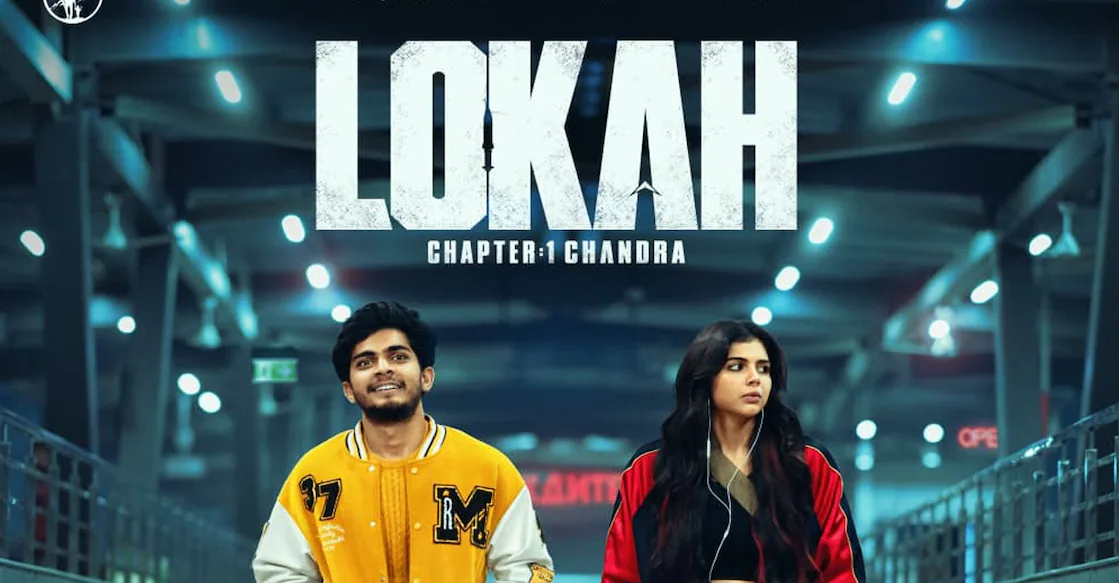
Malayalam cinema has long been celebrated for its storytelling depth, cultural authenticity, and artistic risk-taking. With Lokah Chapter 1: Chandra, director Dominic Arun pushes the boundaries even further, delivering what many are calling India’s finest homegrown superhero film. Anchored in Kerala’s folklore and infused with modern cinematic flair, Lokah is not just a genre experiment—it’s a statement of intent.
Released on August 28, 2025, under Dulquer Salmaan’s Wayfarer Films banner, Lokah Chapter 1 marks the beginning of what is being positioned as the Wayfarer Cinematic Universe. Starring Kalyani Priyadarshan and Naslen in lead roles, the film blends fantasy, thriller, and dark comedy into a visually stunning and emotionally resonant experience.
A Superhero Rooted in Folklore
Unlike recent Indian superhero films that lean heavily on spectacle and mythological name-dropping, Lokah builds its universe from the ground up. The story is set in Bengaluru, where Chandra (Kalyani Priyadarshan), a mysterious woman with supernatural traits, moves into a quiet apartment after living in Sweden for two decades. Her condition is unusual—she can only venture out at night, as exposure to sunlight causes her body to boil. As the narrative unfolds, it’s revealed that Chandra is a yakshi, a female nature spirit from Kerala’s folklore, who has lived among humans for centuries.
This grounding in regional mythology gives Lokah a unique texture. Dominic Arun doesn’t oversell the divine or rely on religious tropes. Instead, he weaves Chandra’s identity into the socio-political fabric of the story, offering a feminist lens and a grounded origin that feels both fresh and familiar.
A Tale of Two Worlds
Across the street from Chandra’s apartment live Sunny (Naslen) and Venu (Chandu Salimkumar), two carefree, unemployed youths whose lives are about to change. Their curiosity about the enigmatic woman next door leads them into a hidden world—one that runs parallel to their mundane existence.
The film’s narrative structure is tight, with every scene serving a purpose. Arun avoids unnecessary detours, maintaining a steady rhythm that builds toward a powerful interval reveal. The screenplay, co-written with Santhy Balachandran, balances intrigue with humor, and the tonal shifts are handled with precision.
The city of Bengaluru is not romanticized but used effectively as a backdrop. Its chaos and anonymity provide a perfect cover for Chandra’s nocturnal life, while also serving as a metaphor for the duality of existence—visible and invisible, ordinary and extraordinary.
Performances That Elevate
Kalyani Priyadarshan delivers a career-defining performance as Chandra. Her portrayal is layered, combining elegance, vulnerability, and quiet strength. She moves effortlessly between moments of mystery and emotional depth, anchoring the film with a presence that is both ethereal and grounded.
Naslen brings charm and comic timing to Sunny, offering a relatable counterpoint to Chandra’s mystique. His interactions with Venu and Nigel (Arun Kurian) add levity without derailing the narrative. Sandy Master, as the corrupt Inspector Nachiyappa Gowda, adds menace and complexity to the antagonist role, elevating the stakes.
The supporting cast, including Nishanth Sagar, Raghunath Paleri, and Vijayaraghavan, enrich the film’s world with authenticity and nuance.
Technical Brilliance
Visually, Lokah Chapter 1 is a triumph. Cinematographer Nimish Ravi crafts a rich palette of shadows and light, capturing Chandra’s nocturnal world with haunting beauty. The color grading is meticulous, and the visual effects—developed by Little Hippo Studios and Pictorial Fx—are immersive without being overwhelming.
Editor Chaman Chakko ensures a smooth narrative flow, avoiding lag and maintaining tension throughout. The film’s pacing is deliberate, allowing moments to breathe while keeping the audience engaged.
Jakes Bejoy’s background score is another standout, enhancing mood and emotion without overpowering the visuals. Guest composers DJ Sekhar and JK add variety to the soundtrack, while lyricists Sasikumar, MuRi, and Zeba Tommy infuse the songs with poetic resonance.
A Cinematic Universe in the Making
Lokah Chapter 1 is not just a standalone film—it’s the foundation of a larger narrative. The story hints at a shadow universe, populated by beings and forces that exist beyond human perception. This world-building is subtle but effective, laying the groundwork for future chapters without sacrificing the integrity of the current story.
The film’s ambition is clear, but it never loses sight of its characters. Dominic Arun’s direction is confident, and his vision is supported by a crew that understands the importance of cohesion. From art direction to costume design, every element contributes to the film’s immersive quality.
Themes and Subtext
At its core, Lokah is a story about identity, belonging, and transformation. Chandra’s journey is not just about revealing her powers—it’s about reclaiming her place in a world that has forgotten its myths. The film explores themes of gender, power, and societal decay, using fantasy as a lens to examine real-world issues.
The organ trafficking subplot, tied to the antagonist’s network, adds a layer of social commentary. It’s a reminder that evil often hides in plain sight, and that heroism can emerge from unexpected places.
Reception and Impact
Early reactions to Lokah Chapter 1 have been overwhelmingly positive. Audiences have praised its originality, visual quality, and emotional depth. Many have called it a refreshing alternative to formulaic superhero fare, and a benchmark for future Indian fantasy films.
Critics have highlighted the film’s writing as its strongest asset, noting that it avoids the pitfalls of spectacle-driven storytelling. Instead of relying on grand gestures, Lokah builds its impact through character, atmosphere, and thematic resonance.
Final Thoughts
Lokah Chapter 1: Chandra is a landmark film in Indian cinema’s superhero genre. It proves that cultural specificity and universal storytelling can coexist, and that fantasy need not come at the expense of substance. With its compelling characters, rich mythology, and technical finesse, Lokah sets a new standard for what Indian superhero films can achieve.
As the credits roll and the promise of future chapters lingers, one thing is clear: Lokah isn’t just a movie—it’s the beginning of a mythos. And if this first installment is any indication, the journey ahead will be one worth following.


Leave a Reply